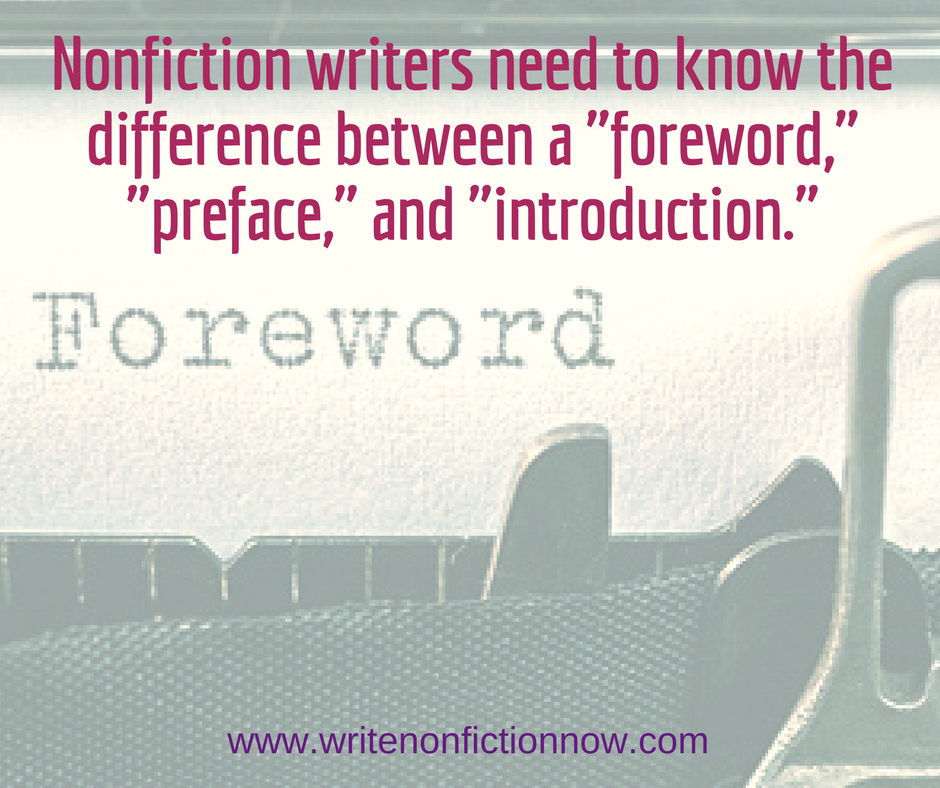Wednesday, December 13, 2017

Foreword. Preface. Introduction. What’s the difference between these parts of a nonfiction book, and which of them are required? In this guest post, book editor
C.K. Bush (
@theladyck) answers these commonly asked questions.
The lingo that editors and other publishing types use for different parts of books and their creation can get confusing. And no publishing terms are more often misused than the words “preface,” “introduction,” and “foreword.”
Sometimes I joke with non-publishing friends that I’ll send them a vocab list before they come to any of my parties. Ever heard of the “recto”? “Blurbs”? “Blanks”? (Respectively, these refer to the right side page of an open book, the nice quotes on the back, and leftover pages at the front or back of a book when the page count is less than the multiple of 16 pages, which is the amount that make up a bundle of pages in a book.)
These terms cause even more bewilderment because they sound like something familiar. For instance, people often use the term “blurb” to refer to the description on the back of the book. In publishing it’s a term most often used to describe praise quotes, solicited or from reviews, that we use on the cover or in advertising.
In particular, many authors struggle with the terms “preface,” “introduction,” and “foreword” (not to be confused with “forward,” a direction in which one travels.) These parts of the book all come at the front of the book, and it’s common to hear people using them interchangeably. Yet, they are actually all different parts, each with a specific purpose.
Foreword
A foreword is a statement written by anyone other than the author that’s then placed at the front of the book. This makes sense when you break down the term:
“words” from someone else placed at the “fore” of the book. A foreword isn’t required to make a good book. In my opinion, it’s best to use this element sparingly and selectively.
A good foreword is one that’s written by someone with a wide reputation and really helps to bolster the book’s credibility. A foreword by your mom on your book on how to get your book published, for example, is not going to do much for you. However, if you got a foreword from a personal friend who is a successful author, that potentially would be useful. If that person is someone with some name recognition, that’s even better! (A note: do not harass public figures you do not know to write a foreword to your book. They will not do it, and you will just seem crazy.)
Forewords generally serve as an extended endorsement. They speak to the merits of the author or the book’s content. They are most useful in books by someone who is breaking out as an author for the first time, or when bringing an older book back into print or into an updated edition. That being said, they are not essential to a book’s success—there are many other ways to solidify an author or book’s credibility through their author biography and other publicity efforts. Forewords are simply “nice to have” elements in the overall bigger picture of creating and launching a book.
A foreword is a statement written by anyone other than the author.Click To Tweet
Preface
A preface also goes at the front of a book before the text. The difference between a preface and a foreword is that the author writes a preface. Like forewords, not all books need to have a preface. They are another element used to augment the main content of the book.
I like to think of them as an opportunity to make a statement about the book that’s useful but not essential for the reader to know before they dig in to the book. They can be an opportunity to refute possible critics if you know the book’s content is going to be controversial. A preface can act as a place to discuss your personal experience with the topic if the book itself is not necessarily personal, such as a history or journalistic account.
It can also serve as a place to put a warning or disclaimer; for instance, if you are writing a memoir about sexual assault, you might consider including a preface warning readers about the content and offering resources for people experiencing sexual trauma.
Some authors also use a preface to include acknowledgements, though many publishers will place these in the back of the book—it depends on your editor and publisher’s preference.
The important thing about a book’s preface is that includes information that will enhance the reading experience, but doesn’t include any information that’s so essential to the book that a reader would be lost without reading the preface. Some readers—I’m sometimes among them—are impatient and will skip or scan the preface to get to the meat of the book. Given this fact, you’ll want to make sure that any really crucial information that a reader will need in the book is in the introduction, not the preface.
The difference between a preface and a foreword is that the author writes a preface. Click To Tweet
Introduction
Introductions, unlike prefaces or forewords, are required for any nonfiction work. You need to start off your book with a chapter that frames the story for readers, lulls them into the reading experience, and explains what’s to come in the rest of the book. I won’t go into too much detail here about how to write the perfect introduction since
I covered the topic previously for this site. Suffice it to say, though, that an introduction differs from the preface or foreword since it is essential to the book. The introduction should contain any information that, if the chapter was removed, the book would be significantly diminished and perhaps make a lot less sense.
You don’t necessarily need to call it “the introduction.” You could call it chapter one, or some other chapter name, so long as it serves the purpose of being an introduction. Some authors like to call this opening chapter the book’s “prologue.” A prologue, however, is really meant for novels or dramas.
Romeo and Juliet has a prologue; your nonfiction book has an introduction. Breaking this rule can make your book seem pretentious and possibly lead to some major eye-rolling on behalf of the reader (and editor).
Introductions, unlike prefaces or forewords, are required for any nonfiction work.Click To Tweet
If you keep these key bits of publishing lingo straight, you’ll be well on your way to starting off your book with writerly sophistication—and you’ll get major brownie points from your editor and copyeditor.
About the Author
 C.K. Bush
C.K. Bush is a nonfiction editor and writer. She lives in New York City.
Photo copyright: Jozsef Szasz-Fabian/123RF.com
The post
What’s the Difference Between a Nonfiction Book’s Foreword, Preface and Introduction? appeared first on
Write Nonfiction NOW!.
Nina Amir, the bestselling author of How to Blog a Book and The Author Training Manual, is a speaker, a blogger, and an author, book, blog-to-book, and high-performance coach. Known as the Inspiration to Creation Coach, she helps creative people combine their passion and purpose so they move from idea to inspired action and positively and meaningfully impact the world as writers, bloggers, authorpreneurs, and blogpreneurs. Some of Nina’s clients have sold 300,000+ copies of their books, landed deals with major publishing houses and created thriving businesses around their books. She is the founder of National Nonfiction Writing Month, National Book Blogging Month, and the Nonfiction Writers’ University. As a hybrid author she has published 19 books and had as many as four books on the Amazon Top 100 list at the same time. Her most recent book is called Creative Visualization for Writers, and tomorrow her 19th book will be released, The Write Nonfiction NOW! Guide to Creativity and Flow. Find all her books at booksbyninaamir.com or find out more about her at ninaamir.com.